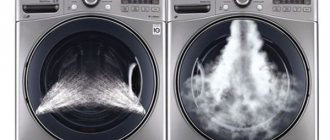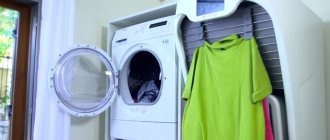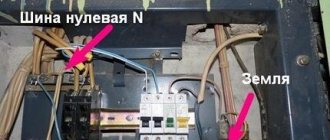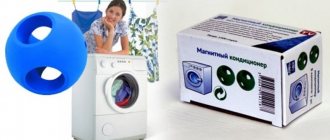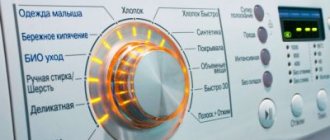Three-phase asynchronous
This motor was invented in 1889 by the Russian engineer Dolivo-Dobrovolsky, and has found wide application in industry, which uses a three-phase voltage of 380 volts. It began to be used in washing machines after the development and widespread use of electronic control systems. The advantage of these motors is their quietness - they are used in quiet washing machines. The main disadvantage is the complex control via the inverter.
In general, such motors are very reliable and rarely fail.
Control
Since houses use a single-phase current of 220 volts, to operate such an engine you need a converter with adjustable speed and direction of rotation. This is a rather complex electronic device, the diagram of which is shown below in the figure.
As can be seen, first the alternating current is converted to direct current in the rectifier. For this, a diode bridge is used. Inductor L, capacitance C and thermistor (in the diagram on the left) serve to protect the module from overloads, and also protects the home electrical network from fluctuations when the machine is operating.
Then the DC voltage enters the power section, where it is converted into a three-phase pulse voltage, whose amplitude and frequency change. It is due to this that the speed and direction of rotation of the engine changes. The tachometer generator (labeled T) provides feedback to the control system. With its help, the module understands the speed of the drum.
The power part is made of bipolar transistors. Changing the rotation of the engine is carried out by changing the switching on of the transistors. The control system, like the algorithm itself, is complex. And this leads to the fact that not every electronics engineer is able to restore this module.
The main failure of such motors is damage to the control board. The engine itself rarely burns out. Note that it is extremely difficult to diagnose a breakdown. On a motor, you can only check the integrity of the windings using a multimeter. You can fully diagnose the health of the engine through the control module.
Inverters come in the following versions:
- in the form of a separate fee;
- integrated with the motor;
- are located on a common electronic module.
Design of inverter-type motors
The main parts are the motor itself and the frequency converter, which ensures the operating principle of the motor. The frequency converter is used to regulate the speed of the motor by creating the required voltage frequency at the output of the converter. The range of output frequency in converters varies widely, and its maximum values can be tens of times higher than the frequency of the supply network.
In the inverter converter, double voltage conversion occurs. The sinusoidal voltage at the converter input is first rectified in the rectifier block, filtered and smoothed by electrical filter capacitors. Next, from the obtained direct voltage , using control circuits and output electronic switches, a sequence of controlled pulses of the desired shape and frequency is set. Using pulses, an alternating voltage of the required magnitude and frequency is created, which is generated at the output of the converter.
The sinusoidal alternating current generated by the converter on the windings of the electric motor is formed by the type of pulse-frequency or pulse-width modulation . Electronic switches for converters are, for example, switchable GTO thyristors, their upgraded versions IGCT, SGCT, GCT and IGBT transistors.
The motor consists of a stator with small field windings, the number of which is a multiple of three. The stator rotates a rotor with permanent magnets attached to it. The number of magnets is three times less than the number of field windings. There is no commutator-brush assembly in such an engine.
All this is an inverter electric motor, the operating principle of which is based on the interaction of the magnetic fields of the stator and rotor . The rotating electromagnetic field of the stator created by the converter causes the frequency rotor to rotate at the same frequency. So, the motor is controlled by an inverter converter
.
Direct drive
The second type of inverter motors is three-phase brushless DC. They were first used by LG in 2005 as a direct drive. It is located directly on the drum shaft. There is no belt. This was a revolutionary solution that became very successful, and is currently used by other manufacturers: Samsung, Whirpool, Haier and BEKO.
It is believed that these motors were developed from stepper motors, which are already widespread, in particular in electrical engineering. They are considered extremely reliable and durable. Therefore, the LG company gives them an extended warranty of 10 years. One of the names is BCDC. Such motors are widely used in dishwashers, as part of a recirculation pump, and are also used in electric bicycles.
One of their features is permanent magnets on the rotor. In direct drive washing machines, the rotor is a metal bowl that is attached to the drum shaft. There are permanent magnets inside it.
The stator is the stationary part and is connected to the outside of the tank. It is a circle covered with plastic with places for winding coils. Inside there are electrical plates. The tachometer generator is also located here.
The control system is similar to the asynchronous motor discussed above. The inverter converts single-phase alternating voltage of 220 volts into three-phase direct voltage. Its parameters can vary in voltage - from 0 to 120 volts, and in frequency - from 0 to 300 Hz. The control circuit and logic is quite complex and is not discussed here, since it is only needed by specialists.
Direct drive inverter motors have the following advantages:
- simple design;
- low noise;
- absence of a drive belt, and as a result, reduction of friction losses;
- there is no brush assembly - there is no need to change brushes and there are no problems due to dust settling.
There is only one drawback - a complex and expensive control system. Note that there has been a trend away from commutator motors, but nevertheless they are the basis of most automatic washing machines.
By clicking on the “Publish” button, you consent to the processing of your personal data.
Relatively recently, washing machines with inverter electric motors appeared on the household appliances market. From the very beginning, they began to enjoy increased interest from buyers. They have distinctive features that you should be aware of before purchasing. This article will discuss the advantages and disadvantages of such devices.
How to care for your inverter
Motors in washing machines do not require special care, such as water supply filters or powder containers, which need to be cleaned every 1-3 months. If the inverter motor is faulty, the machine will not start and an error code will appear on the display (for Haier machines this is code F7). You won’t be able to repair it yourself; you need to contact the after-sales service department of the store where you bought the equipment. Almost any damage is reversible.
From the general operating requirements for Haier washing machines:
- Do not overload the device (your hand should move freely over the laundry).
- Do not wash small or sharp objects that could damage the drum or fall into it.
- Avoid leaks and use only the original hose set.
- Regularly check that all connections (power supply, drainage and cold water supply hoses) remain tight, dry and waterproof.
Types of washing machine motors
For normal operation of a household washing machine, you need an electric motor that can change the direction and speed of rotation of the shaft depending on the operation being performed. Not every power unit is designed for this.
Currently, you can find units with three types of engines:
- Collectors, which have an internal copper drum divided into sections and brushes rubbing against its surface, designed to transmit current to moving parts. They pick up speed quickly and are relatively easy to adjust the speed. Their most significant disadvantages are the excessive noise generated when the brushes rub and the need to regularly replace worn parts.
- Asynchronous, having main and auxiliary windings offset by a certain angle relative to each other. They make less noise, but require the use of a more complex electrical circuit with additional devices.
- Inverter ones, to which this page is dedicated.
For information! Washing machines with an inverter engine type are almost no different in appearance from other models. Find out the necessary information from the seller or carefully read the product data sheet.
Top or front loading
This is one of the main questions facing the buyer. What is the difference? Each download type has its pros and cons. Washing machines with a vertical loading type are more compact in size, so they can be placed in the bathroom or kitchen, where there is relatively little space.
Also, some housewives find it easier to load laundry into them, since they don’t have to bend over too much. Among other things, when opened, the lid does not take up useful space, since it opens upward. In vertical models, the drive is equipped with additional counterweights, so their vibration level is lower than that of front-facing cameras (if compared within the same brand).
However, in terms of the volume of loaded laundry, vertical ones are inferior to front ones - you can rarely find a model with a capacity of more than 7 kg. Also, before purchasing, it is worth checking whether there is a drum parking system, that is, the ability to stop after work with the lid up. For example, in old vertical machines the drum could stop at random, after which it had to be turned by hand. Modern cars usually have a drum parking. Among the vertical ones with an inverter motor, we would like to recommend the Gorenje WT 6213 with a 6 kg load capacity.
Front-loading models allow you to accommodate much more laundry, which will be a definite plus for a large family. Thus, front-facing machines can hold from 4 to 15 kg of laundry (then come industrial models).
The best front-loading inverter washing machines have a spin speed of 1400 - 1600 rpm. At this speed, the laundry turns out almost dry. And a huge number of programs will allow you to choose the right one for a specific type of laundry.
However, the advantages of front-facing vehicles affected their dimensions. They require much more space (although there are also compact models). Opening the lid will also require additional space. With equal loading and within the same brand, front-facing machines are slightly more expensive than vertical ones. One of the popular front-facing models with an inverter motor is LG F-1096TD3 . It will satisfy the needs of a large family as its capacity is 8 kg. At the same time, it has low energy consumption - 0.17 kWh/kg.
Inverter motor in a washing machine: what is it?
To understand what an inverter motor is in a modern washing machine, you need to understand the features of its design and imagine the principle of operation.
Design Features
The main element that indicates that it is an inverter motor in the washing machine in question is the inverter. This electronic converter is capable of first changing the incoming alternating current with standard characteristics of 220 V and 50 Hz into direct current, and then again generating alternating current, but at a given frequency. Smooth control of this parameter is capable of setting the rotation speed of the rotor, and with it the machine drum, with high accuracy.
Read also: Do-it-yourself adjustment of the carburetor of the Shtil 660 chainsaw
The presence of such an intelligent unit complicated the electrical circuit of the product and slightly increased its price. For this, the user received a lot of advantages that were discovered during the operation of the unit.
The inverter motor does not contain rubbing brushes and operates with a reduced noise level. It has a more compact design and can be located on the same axis with the drum. The absence of a belt drive in this case reduces wear on moving parts and extends the life of the machine.
Principle of operation
The operating principle of an inverter-type motor in a home washing machine, as well as for electric motors of other designs, is based on the use of the phenomenon of electromagnetic induction. But there is also a significant difference. Instead of graphite brushes, the role of controlling the winding currents was taken on by an inverter.
As a result, the rotating rotor has become less inertial and is easier to pick up the required number of revolutions. There are no rubbing parts inside such a device, which has led to a reduction in unwanted heating and waste of energy. This motor operates reliably at the highest speeds.
On a note! A modern inverter motor often takes the form of a disk with a shaft located on its central axis.
Advantages and disadvantages
To evaluate what an inverter motor in a washing machine means for a housewife, it is enough to list its strengths and weaknesses.
- A perfect control system provides higher efficiency, which, according to experts, leads to a reduction in current energy costs by 20%.
- The absence of rubbing parts reduces wear of parts, simplifies maintenance, and extends the service life of the unit.
- The reduced noise level does not cause any inconvenience to users. This is especially important for families with small children and sick people.
- Surprised by the high spin speed, many of us do not realize that it is the inverter motor in a modern washing machine that allows the drum to accelerate to 1600 or more revolutions per minute.
- The inverter provides exceptional speed control accuracy.
- The small size of the motor makes it possible to mount it on the same shaft as the drum, which results in a more compact size of the machine and simplifies balancing of a loaded drum.
- The cost of inverter machines usually exceeds the price of conventional units.
- Repair work, especially those related to replacing the inverter, will cost the owner a tidy sum.
Important! The initial excess cost of purchasing an inverter machine will be recouped by saving energy consumption and extending the service life of the product. Minimal friction, a reduction in the number of rotating drive parts and more accurate balancing of the unit will delay the time of the first repair for a long time.
Comparison of performance characteristics of washing machine motors
Let's analyze some of the operating parameters that always worry the end user, who expects positive results from investing his money in the purchase of complex household appliances.
We will consider:
- electrical energy consumption for washing equal volumes of laundry;
- the intended duration of operation with strict adherence to the manufacturer’s recommendations;
- the number of operating modes established by special programs;
- washing comfort for the end user.
How electrical energy is consumed by different types of motors: which one is better?
This issue is so pressing that the European Union Commission, through its directives, has strictly established technical control standards. The latest changes for washing machines and clothes dryers were approved in 2010.
Such products are assigned an energy efficiency label, which takes into account the energy consumption for processing 1 kg of laundry (cotton cycle under control of a certain water temperature).
The most frugal models are assigned an A+++ grade, while the spendthrifts are assigned a D grade.
In other words, all the work of determining the cost of electrical energy for washing clothes and calculating the quality of washing is carried out for us by the EU Commission on Energy and Transport. Its results can be completely trusted.
To do this, when purchasing equipment, it is enough to familiarize yourself with the energy efficiency label, which manufacturers of branded devices do not hesitate to display directly in the most visible place of the case - the upper left corner.
If we consider separately the energy consumption of single-phase asynchronous, commutator or inverter motors, then you can make a lot of mistakes yourself, because they have different regulation principles:
- collector motors sharply reduce torque when the voltage amplitude decreases due to trimming part of the signal waveform;
- asynchronous machines react sharply to changes in slip;
- In inverter models, only two-thirds of the windings almost always work, and the rest is idle according to the technological cycle.
In addition, any owner of a washing machine is interested not so much in the economical operation of the engine alone, but of the entire machine as a whole, purchased for washing. After all, energy losses can occur in other places:
- rubbing or rotating parts, such as bearings;
- a pump that pumps or drains water;
- narrowed or clogged hydraulic lines;
- deterioration of heat transfer of the heating element surface by a layer of salts deposited on it;
- clogged filter.
All these processes have already been compared and evaluated by EU specialists in their laboratories. We simply use the end results of their work.
Product Warranty and Reality
Each manufacturer independently determines the time period during which it will eliminate defects and breakdowns that were discovered during the operation of the product due to its fault free of charge.
For example, LG, Samsung, Atlant and a number of others have 3 years for warranty repairs, and Bosh - two. Different deadlines can be found with different companies.
It is important to understand that the right to a free service can be lost for various reasons, for example:
- incorrectly completed purchase documentation;
- violation of connection technology;
- damage caused by the owner;
- attempt at self-repair.
Here I once again emphasize that the manufacturer gives separate, extended warranties for some components, like for an inverter motor - as much as 10 years.
In most cases, you should look at such things realistically: breakdowns are practically excluded, and the declared guarantee is a skillful marketing ploy.
How washing modes affect the final cleanliness of the laundry and the performance of the motor: briefly
Modern washing machines have quite a large number of options for processing laundry.
Their choice affects not only the cleanliness and strength of the washed fabrics, but also the technical condition of the machine itself, since various mechanical loads, vibrations and thermal processes are created inside it.
Spin speed
The desire to dry clothes almost to a dry state forces you to set the washing drum rotation speed to the highest possible speed. This creates maximum impacts on the body, shock absorbers, drive mechanics, and electric motor.
Using it several dozen times does not immediately affect performance. But, if you use this mode constantly, then there is a very high probability that the resource declared by the manufacturer will end much earlier than expected.
Thrifty housewives set the engine speed for spinning to the minimum required limit: 400 or 800 rpm. Yes, the laundry turns out somewhat damp. But it doesn’t take that long to dry to normal on the ropes...
Increased spin speeds and the vibrations they create most have a harmful effect on the bearings of commutator and asynchronous motors, even taking into account the fact that they operate through a belt drive.
Water temperature and separate wash
The hardness of our tap water negatively affects the general technical condition for the reason that when heated, dissolved salts of sodium and potassium carbonates begin to be released from it. They deposit scale on all internal cavities.
These deposits interfere with normal washing, increase the rigidity of the gaskets, and impair their plasticity and waterproofing properties. As a result, leaks of the washing solution are created.
They have pronounced alkaline properties, corrode the silumin fastenings of the washing drum, and contaminate the bearings. All this affects the engine loads.
Extending the life of your washing machine is not difficult. Enough:
- use water filters;
- do not heat the water above 40-50 degrees;
- regularly carry out preventive cleaning of lines.
Weight of laundry loaded into the drum
This parameter is specified in the passport and is physically limited by the dimensions of the container for storing laundry. However, using it to the maximum is often not advisable.
In solution spin modes, the laundry should be evenly distributed throughout the entire internal cavity. Otherwise, the center of mass shifts, which not only causes increased vibrations on the shock absorbers, but also creates shaking and even jumping of the body.
Such shock loads are transferred to the rotating motor rotor and its bearings. Their work resources will be reduced.
Manufacturers of inverter washing machines
Back in 2005, Japanese and Korean manufacturers of washing machines were the first to actively install inverter motors on their products. The LG concern has achieved the greatest success in this direction, having developed the Direct Drive engine. It is economical, makes almost no sound and quickly accelerates to high speeds. In addition, this company has applied interesting innovations in the field of optimizing the layout of components, improving the design of the drum, and expanding the associated functionality.
Characteristic in this regard is the 6 Motion model, which uses 6 types of movement in the laundry process:
- Typical for all drum machines.
- Reversible, helping to improve the dissolution of washing powder.
- Rocking during the initial soaking stage.
- Torsion used for long-term washing.
- Saturation, ensuring uniform distribution of the washing solution over the laundry being treated.
- Spin smoothing, making it easier to iron items after removing them from the machine.
Models of the Cristal Standard series from Samsung, equipped with inverter motors, use a bubble washing mode that can effectively remove dirt even at a temperature of 15 ° C. This combination significantly saves users time and money. At the same time, the machine is distinguished by high reliability and undoubted aesthetic advantages.
Among European brands, Electrolux, Bosch, and Candy actively use inverter technologies. AEG has so improved the design of its washing machines that it offers a ten-year warranty on them.
Advice! Don't chase a sonorous name! Adherents of budget options should pay attention to the products of the Belarusian company Atlant. It is not much inferior to representatives of well-known foreign manufacturers, but the purchase and repair of products of this brand will not have such a big impact on the owner’s wallet.
Models of washing machines and dishwashers
The first company to produce washing machines with such an engine was LG. Today, such motors are installed by many well-known brands, including Samsung, Indesit, Electrolux and many others. Due to the large number of options, the greatest demand among buyers is for washing machines whose operating principle is based on Direct Drive technology.
The following washing machines with inverter motors are in demand among buyers:
- Samsung WW70K62E00W - narrow front design is equipped with touch controls and an LED display. The model is equipped with a steam treatment function and an Eco Bubble function. Capacity reaches 7 kg. An important advantage is the quiet operation.
It is possible to control from a smartphone. - LG FH-0B8ND4 is a front-facing machine with a removable lid. The capacity is 6 kg, the number of programs is 13, there is no drying, there is a delay timer for washing - the program is activated at the set time.
The model is equipped with a digital display. - Electrolux EWS 1277 FDW - capacity reaches 6.5 kg. The main advantages are excellent assembly and noiselessness.
14 programs allow you to wash any fabric.
Tips for selection and operation
Modern direct drive models based on an inverter motor are undoubtedly a big step forward in the development of washing technology. At a relatively high price, they offer advantages in energy consumption, reliability, ease of use and exceptional functionality. If the issue of cost is not critical for you, purchase a truly indispensable assistant for your household.
When choosing a model, you should pay attention to the following indicators, which can be found in the product passport or directly on the machine body:
- Limit weight of loaded laundry. For families with small children and people leading an active lifestyle, the weight of a batch of items for one wash often reaches 6-8 kg.
- Energy efficiency class. It is expressed by a Latin letter with crosses to the right of it. The more there are, the better. The most economical models are marked A+++.
- Maximum spin speed. Acceleration to 1600 or more rpm ensures almost complete removal of moisture. You will use this speed often, but not always. Make sure you can set the rotation speed yourself. It is better to spin delicate fabrics on a gentle cycle.
- Noise level. If you don’t want to shudder when the machine switches rotation speeds, buy a unit that produces no more than 75 dB during spinning.
- Functionality of the machine. Most manufacturers equip their products with special programs: economical washing, gentle mode, heavy soiling, prewash, steam treatment, no ironing and many others. Some owners will come in handy with cars equipped with a timer for delayed start.
- Security options. Expensive models are characterized by maximum safety. Cars with protection against children, leaks, and excessive foaming have additional advantages.
You have already guessed that you should not buy a washing machine based on the only principle “as long as it has an inverter motor”. It only gives the manufacturer ample opportunity to implement a large number of useful functions. Whether the model you like has the options you need, check with the seller or study the technical documentation.
Lately, inverter washing machines have become popular among many housewives. But no matter how widespread this type of technology is, not everyone knows what it is. Many are only convinced that an inverter electric motor is much better than a conventional one and has certain advantages over it.
Is this statement true? Let's try to figure it out. In the article, we described in detail the specifics of the device and the operating principle of such washing machines, outlined the advantages and disadvantages of inverter motors, and also provided tips on choosing and servicing a home assistant.
To narrow down your search, we have prepared a rating of the best models, indicating their operating parameters and functionality.
Causes of problems and diagnostics
Despite the simplicity of the design and the apparent reliability of the components of washing machines that use an inverter motor, they also fail. The most common reason is a malfunction of the Hall sensor. In LG machines, such a malfunction is displayed by the error code “SE” on the digital display.
Figure 6. Hall sensor
The problem can also be diagnosed based on the metallic rattling sound produced by the device. All this is accompanied by the rotor stopping and its inappropriate behavior. Replacing a suspected faulty element with a known good one is the only way to confirm your fears. The difficulty is that it is impossible to diagnose the motor outside of the washing machine, except by ringing the phase windings using a digital multimeter.
Figure 7. Checking coils with a multimeter
Malfunctions in the inverter can also cause a malfunction, but it is not possible to identify such a malfunction without special equipment and knowledge in electronics.
How to replace the motor and connect it to the washing machine - read on the website at the link.
What is special about an inverter motor?
Previously, these types of components were used exclusively in microwave ovens and air cooling systems, and they began to be used in the production of household appliances relatively recently.
Read also: The best budget welding inverters
The start was made when Korean and Japanese engineers began to use this technology in the design of washing machines. This innovation made it possible to improve the characteristics of the equipment and extend its service life.
The main feature of the inverter engine is its ability to “level” the current - convert alternating to direct. Thanks to this ability, the user is able to precisely adjust both the speed and the rotation frequency of the reel.
Determining the type of engine
Turning on the engine depends on the type. Therefore, before connecting the motor, it is advisable to find out which mechanism you got. Washing machine packages include three types:
- asynchronous;
- collector;
- inverter (brushless).
Asynchronous washing machine motor
Installed in cars manufactured before 2000. The engine of a semi-automatic machine has 2800 rotations per minute and a power of 180–360 W. To adapt such an engine for garage “homemade” products, you need a three-phase network, a frequency converter, and a set of capacitors. This is expensive, which is why asynchronous systems are not popular among do-it-yourselfers. But if you come across just such a copy, you don’t have to worry about technical difficulties. The design of the engine is simple and easy to maintain.
Brushed motor
A favorite of the masters. Operates on direct or alternating electric current, power 300–800 W, armature rotation speed 11,500–15,000 rpm. On the plus side, the cycle can be easily adjusted without loss of power. The downside is that the brushes wear out often. A commutator electric motor is the best option in terms of availability and price for home workshops. It is versatile and easy to manage.
Inverter motor
The most modern, economical look. Converts alternating current to direct current. It operates without a belt drive, brushes, with a power of 400–800 W, making a number of turns from 16,000 to 20,000. No capacitors are needed to connect it, it can change the direction of rotation, it works quietly, without unnecessary vibration. Disadvantages: expensive, sensitive to changes in network voltage.
The identification has been carried out - we begin to start the electric motor.
The operating principle of such washing machines
This type of washing machine operates by inverting the current. To put it simply, the voltage is pre-converted and only after that is supplied to the stator. As a result, the engine speed is adjusted with greater accuracy, which allows you to significantly expand the number of washing modes.
Inverter machines can spin at speeds above 1,200 rpm. Accordingly, after the end of the washing cycle, clothes and clothes practically do not need additional drying. Such indicators were achieved thanks to the brushless design.
The program is selected via electronic or mechanical control. In the latter case, the mode is indicated using buttons, which is considered a more durable and reliable solution.
Well, in the case of electronic control, to start the wash you only need to press one button and the device will do everything on its own.
Types of devices to check
In addition to the standard set of tools (pliers, a set of screwdrivers and wrenches), you will need an electrical device that performs the “diagnosis test” of the motor.
Multimeter
Previously, a multimeter was called an avometer - it was a pointer device that measured resistance, voltage and current. Today, pointer instruments have almost completely disappeared from the market - with the exception of miniature, modern versions, which are difficult to find. They have given way to digital counterparts that allow you to check diodes, capacitors, inductors and windings, and even the health of transistors.
Tester
The same as a multimeter, but can be made independently - from any pointer galvanometer. To carry out measurements, the tester switches to the resistance measurement mode (values on the sector with the designations Ohm and kOhm).
The device received the name “continuity” because of its buzzer mode: when the resistance is below 200 Ohms, an audible alarm is activated.
Pros and cons of inverter technology
The emergence of improved models of washing machines was a real discovery. After all, in terms of energy efficiency, they were ahead of all previous ones by as much as 15-20%. But this is not all the advantages of devices running on inverter motors.
The first and one of the most significant advantages is saving water. Minor changes to the drum design reduced costs by 10%.
Many will say that this is not a very large number. But for those who do a lot of washing often, this is a good reason to order such equipment.
Most of the latest models are equipped with a Beat Wash . Its essence lies in the presence of a special 3D sensor. This detail significantly improves washing efficiency.
How does he do this? The whole problem is adjusting the movement of things inside the drum. The laundry is evenly distributed, making washing more delicate and faster.
The list of advantages of an inverter motor should be supplemented with the following characteristics:
- noiselessness - depending on the selected program, the noise level varies from 52 to 75 dB;
- high-speed spin - clothes are almost dry after washing;
- accuracy - the number of revolutions is adjusted with mathematical precision.
If we talk about the disadvantages, then they include the high cost and complexity of repairs. After all, such technology appeared relatively recently, which creates certain problems.
A comparison of different types of washing machine motors and recommendations for their repair are given in this article, we recommend that you read it.
Troubleshooting
Before you repair the motor at home, check which of the three types of motors is used in your washing machine.
Asynchronous
Obsolete type. Despite its simplicity, magnets on the rotor and stator windings, without rings and brushes, have been forced out of the market of modern household appliances due to low power output and impressive dimensions. It has found application only among users as a generator - the assembled installation can operate for 30 years or more without repair. As a consumer, it is useless: it produces half as much energy as it takes from the power grid, the rest is spent on losses in operation.
Its improved version is a stepper motor with ten windings, which requires a pulse driver board. In the stepper motor, low efficiency is eliminated - the “stepper” has a very strong thrust (torques of torque generated when current pulses are sequentially applied to different coils).
But such a scheme is not used in automatic washing machines - the speed is too high, a powerful high-frequency driver with a clock frequency of tens of kilohertz would be required.
Collector
Has significantly higher efficiency. The rotor and stator are a set of independent windings connected in series. The rotor circuit is divided into a dozen winding sectors, each of which has a pair of lamellas - sliding copper or copper-plated contacts fixed to the shaft. The number of lamellas can reach 20 or more, depending on the number of windings.
To prevent the lamellas from wearing out, graphite brushes are used instead of copper contacts. The brush has the form of a parallelepiped, a kind of “brick” up to a couple of centimeters long, connected using a bronze or brass contact pressed into it, to the end of which a copper stranded conductor is soldered.
Graphite has a resistivity hundreds of times greater than a copper conductor, but its conductivity is sufficient to power the rotor windings with the required amount of current - they have a resistance of 1-4 Ohms.
The rotor assembly is connected in series with the stator, whose windings, like the primary coil of a transformer, have a resistance of up to 200 Ohms.
Direct drive
It has increased efficiency due to additional magnetization from permanent neodymium magnets. Such a motor costs noticeably more than others, but, like a stepper motor, it produces high efficiency - about 90-95%. Does not require belts or gears through which torque is transmitted to the drum.
If the engine does not spin or operates intermittently, then the first thing to check at the commutator is the serviceability of the brushes. Pull them out - worn brushes become several times shorter than new ones: graphite is a soft material and wears out quickly with intensive, long hours of work. This is the main disadvantage of a commutator motor.
How to make a choice?
Every developer of household appliances will undoubtedly praise their products and talk exclusively about their advantages, keeping silent about the disadvantages. Therefore, the buyer is faced with the problem of how to make a choice and not make a mistake with the optimal model.
Washing energy efficiency class
When buying a modern washing machine powered by an inverter motor, you need to pay attention to the following characteristics:
- energy efficiency class;
- spin speed;
- equipment dimensions;
- drum capacity;
- noise level;
- options.
Each of these factors plays an important role. If you make a mistake in even one of them, you can waste your money.
First of all, a wise buyer will pay attention to the energy efficiency of the device. In the case of washing machines, they are divided into 7 classes, which are designated by letters from G to A.
The first category includes those models that provide the lowest level of energy savings, but they also have a low price. Well, category A is assigned to the most economical units.
Optimal spin speed
Today, manufacturers offer simply a huge range of washing machines that can accelerate to 2,000 revolutions per minute.
Buying a high-speed washing machine will cost you quite a hefty sum. The reason for the high cost is the quality of the components.
Indeed, to ensure such high speeds, it is necessary to use only expensive electric motors and durable, wear-resistant bearings.
Dimensions and capacity of the drum
A wise decision would be to first prepare the place where the equipment will be installed in the future. In this case, the optimal dimensions of the equipment will become clear, which will avoid additional difficulties.
When choosing a washing machine, be sure to check the capacity of the drum. If the device is used by one person, then the model for 3 kg of laundry will be more than enough.
In the case of a family of 4, things are completely different. Here you will need a unit that is designed for 5 or even 6 kg of things.
Noise level and functionality
Loud sound interferes with household chores and can negatively affect your health. Therefore, the best choice would be models that emit noise not exceeding 75 dB during spinning.
Many manufacturers' product lines include virtually silent washing machines - such offers may be of interest to families with small children.
In the case of functionality, everything is a little more complicated. As a rule, most washing machines have a preset set of programs.
But in addition to the standard ones, the units boast several dozen additional modes. You need to choose them based on your personal needs.
Scheme for connecting the motor to the network
Modern washing machine
When connecting the motor of a modern washing device to a 220V network, it is necessary to take into account its main features:
- it works without a starting winding;
- The motor does not need a starting capacitor to start.
To start the engine, the wires coming from it must be connected to the network in a certain way. Below are diagrams for connecting brushed and brushless electric motors.
First of all, determine the “work front” by excluding contacts that come from the tachogenerator and are not involved in the connection. They are recognized by a tester operating in ohmmeter mode. Having fixed the tool on one of the contacts, use another probe to find the paired pin. The resistance value of the tachogenerator wires is about 70 Ohms. To find pairs for the remaining contacts, call them in the same way.
Now we move on to the most important stage of work. Connect the 220V wire to one of the winding outputs. Its second output needs to be connected to the first brush. The second brush is connected to the remaining 220-volt wire. Plug in the motor to check its operation*. If you have not made any mistakes, the rotor will begin to rotate. Keep in mind that when connected like this, it will only move in one direction. If the test run went without any pads, the device is ready for use.
To change the direction of movement of the motor to the opposite, the connections of the brushes should be swapped: now the first will be connected to the network, and the second will be connected to the winding output. Check the readiness of the motor for operation as described above.
You can clearly see the connection process in the following video.
Which brand of washing machine do you prefer?
The first company to start producing cars with inverter motors is LG . Of the impressive range of models, the most in demand are devices whose operating principle is based on Direct Drive .
The distinctive features of such a motor are the ability to fine-tune the equipment, a convenient door, and an improved drum design. LG has paid special attention to detail. For example, engineers worked on the drum and made its surface pimply.
The laundry grips have also been changed. These elements have had their shape adjusted and their height increased. As a result, such solutions made it possible to achieve a delicate effect on the fabric and the highest quality washing.
Europe is not lagging behind in the production of this type of equipment. On the market you can find many models of inverter equipment from companies such as Candy, Whirlpool, Electrolux and many others.
Principle of operation
The main feature is the ability to equalize the current, as a result it is transformed from alternating to direct. The difference from an electric motor is the absence of carbon brushes, as well as the use of a frequency converter.
The operation of the converter is based on electromagnetic induction.
The rotor mechanism rotates due to the action of electromagnetic fields, which leads to an increase in the service life of the component. The inverter, after receiving direct current, again produces alternating current, which allows the rotor to be adjusted.
The rotor operates at high speed and at the same time quite clearly.
The control circuit of an inverter-type motor is complex and requires effort and investment, which leads to an increase in the cost of motors. Samsung installs such engines on various household appliances and equips the models with technological control units, which allows them to avoid significant increases in price.
When purchasing a unit with an inverter-type engine, the owner can significantly save the family budget.
Popular models of inverter machines
The range of machines powered by an inverter motor is expanding from year to year. This range of choice allows a buyer with any income level to choose the optimal model that will satisfy all his needs.
But the huge catalog also creates certain problems. After all, sometimes it’s not easy to find equipment that’s worth the money. Therefore, before placing an order, it will be useful to learn about the device options that have already earned the recognition of thousands of customers.
Location #1: Electrolux EWW 51685 WD
Electrolux EWW 51685 WD takes first place in the list of reliable household appliances. It is equipped with an innovative inverter direct drive motor. It differs from analogues in class A energy consumption and increased operating efficiency .
This is a frontal unit, standing separately. With a depth of 60 cm, you can load about 8 kg of linen and clothes into it. The model is equipped with a drying capacity of up to 4 kg. Thanks to these parameters, it will be able to serve a family of 4-5 people.
As for the controls, it is electronic. There is a display on the front panel that greatly simplifies operation. The required washing mode is selected using the rotary knob. Well, additional parameters are indicated using touch keys.
Read also: DIY tool organizer for the wall
The model has standard modes:
In addition, the user is invited to use one of the special modes if he needs to wash duvets, as well as items made of silk and wool.
The drying function deserves attention . Many modes allow you to dry your clothes and clothes without over-drying them.
Place #2: LG F-1096 ND3
When you need to order a narrow washing machine, the South Korean model LG F-1096 is a good choice. It can wash about 6 kg of clothes, which will be relevant for a family of 3 or 4 people.
The manufacturer took a responsible approach to software development. An intelligent control system was built into this model . That is, if necessary, the device will independently adjust the washing parameters.
This is a full-size version of this washing machine from LG, which can be easily integrated into a cabinet or bathroom countertop, as it has a removable top cover.
The list of modes is quite extensive - it includes about 13 different programs. Therefore, choosing the optimal one for a particular fabric will not be difficult.
The main advantage of the LG F-1096 ND3 can be considered its efficiency. It corresponds to class A++ , but this affected the performance of the equipment. When ordering this washing machine, be prepared that your laundry will remain quite wet after the program ends.
This situation can be corrected by restarting the spin mode, but this will accordingly lead to an increase in energy costs.
The model belongs to a range of high-tech equipment - thanks to the Smart Diagnosis , you can quickly determine the cause of the malfunction. This will help the service center specialists solve the problem as soon as possible.
Seat #3: LG F-1296 ND3
In terms of dimensions and maximum weight of laundry, the LG F-1296 ND3 is comparable to the analogue above. The main difference is in appearance. In this case, the machine is painted white, while the door has a stylish chrome rim.
The energy efficiency of the model corresponds to class A+ . In practice, it has been proven that the entire washing cycle requires about 1 kW of electricity, while about 56 liters of water are required. This is a pretty good indicator.
In addition to standard modes, the LG F-1296 ND3 boasts the following washing programs:
- Duvet - using this solution, you don’t have to worry that the filler will clump into a single lump.
- Children's items - this feature will be useful for families with small children.
- Taking care of your health - the program is relevant for users prone to allergies, because it allows you to wash the powder much more thoroughly.
The model is equipped with a system against water leaks and has a child lock . It should be noted that the latter function works with all buttons with the exception of the off and on keys.
LG F-1296 ND3 is equipped with a direct drive system. This means that the electric motor is directly attached to the drum, which ensures greater efficiency and durability of the device.
Seat #4: AEG L 574270 SL
An excellent choice for a large family would be the AEG L 574270 SL. This model provides the ability to wash about 6.5 kg of clothes and linen at a time. In addition, the spin cycle is carried out at a speed of about 1200 rpm, so even things made from the coarsest fabric will be practically dry after washing.
The controls are simple and intuitive. On the front panel of the device there is a display where washing parameters are displayed.
OptiSens technology deserves attention . This is a smart system through which the washing machine adjusts the washing time depending on the type of laundry. You can find out the exact cycle time after 15 minutes from the moment the program starts.
Fuzzy Logic technology, the model was able to evaluate the type of fabric and the amount of laundry. The device compares the received data with information stored in memory. After this, the optimal cycle time and spin speed will be selected.
The depth of AEG L 574270 SL does not exceed 45 cm. Such dimensions make it an ideal choice for small apartments.
At the same time, the washing machine is equipped with a reliable and highly effective security system - there is a lock against accidental pressing, protection against water leaks, as well as control for the imbalance of items in the drum.
Location #5: Siemens WD 15 H541
Cost-effectiveness, efficiency and capacity are only a small part of the advantages of Siemens WD 15 H541 inverter technology. Thanks to its unique characteristics, the model stands out from the gray mass of its competitors.
The unit is equipped with a luminous display , thought out to the smallest detail. At the same time, control is as convenient as possible. It is clear that the engineers paid attention to every detail.
As for energy consumption, the Siemens WD 15 H541 model corresponds to the highest category - class A+++ .
But this did not affect performance - it has a high washing and spin class, which correspond to class A. That is, the clothes will be perfectly clean, while one cycle will require a minimum of electricity.
A Siemens washing machine with product number WD 15 H541 can wash about 7 kg of laundry at a time. This will be enough for a large family of 4 or even 5 people. In addition, the machine is equipped with a drying mode (up to 4 kg).
If we talk about the disadvantages, the above technique consumes a considerable amount of water in one cycle. Yes, and there is no washing mode for sportswear and shoes.
Asynchronous motor
Asynchronous motors are less revving and develop speeds of less than 1500 rpm when powered by a voltage of 220 V. Their design contains two windings:
- launcher,
- working
Therefore, before connecting the electric motor from the washing machine, you first need to correctly identify these windings. Typically there are four wires coming out of an induction motor. But there are also three. Each pair in a four-wire motor corresponds to a specific winding. It is known that the resistance of the starting winding is greater. Therefore, in order to find which winding is which, you need to measure the resistance of each of them with a tester. In principle, to operate an asynchronous motor from a 220 V network, it is enough to connect only the working winding to it.
But the problem in this case will be with engine overclocking. It will be necessary to apply an external force to spin the shaft to a speed at which the engine will independently reach operating speed. This starting method, especially if there is a load on the shaft or especially the gearbox, is unacceptable. For this reason, a starting winding is used. To understand what to do with it, you need to familiarize yourself with the connection diagrams for such engines. They clearly show that in any circuit one terminal of the working winding is connected to one terminal of the starting winding.
Therefore, the engine model that has three wires already has a connection of these windings inside the case, and all that remains is to complete one of the circuits. How to figure out which winding is which is clearly shown in the diagram at the top right. The user decides which scheme to choose. In principle, you can only use a button that you press when starting the engine. Then, at start-up, the torque on the motor shaft will be the largest of all the circuit options. But in this case, the maximum load on the button contacts is obtained due to the largest current in the starting winding.
In addition, there is a risk of burning this winding if it is connected directly to the network for too long (and it is not known how long it can be powered with 220 V by connecting directly to the network). The same thing will happen if the value of the resistor is too small and the value of the capacitance is too large. Therefore, to increase the starting torque, a high-capacity capacitor is switched off after the motor shaft accelerates. The most balanced option is “Capacitive phase shift with a working capacitor”. This scheme is recommended for use without any reservations. Especially if the engine starts with an unloaded shaft and the capacitor capacity is small, about 1–2 µF.
The direction of rotation of the shaft of an asynchronous motor from a washing machine depends on the order of connection of the terminals of the starting and working windings. If three wires come out of the motor, it will not be possible to reverse it without breaking the connection of the winding terminals hidden in its body. To reverse, the terminals of the starting winding must be swapped.
24.02.2016
Thanks to
"AS"
M" "T"
Please enable JavaScript to view the comments powered by Disqus.
Over time, washing machines become outdated and fail. And any business person will definitely ask the question - “Where can I use the motor from a washing machine?” because This electric motor is high-revving and it may seem that it is absolutely useless in everyday life.
BUT! Don't rush to throw away this engine!
Thanks to this motor, enormous application potential opens up. Let's figure out how to connect a collector electric motor from an automatic washing machine using a speed control board without loss of power.
Wiring diagram for the electric motor of an automatic washing machine
In order to connect the electric motor to the board or directly to the network, you need to understand the wires it has. For this you will need a multimeter. The motor has three (sometimes four) groups of contacts: Motor winding (can consist of two or three terminals with a midpoint); Electric motor brushes (two wire leads); Tachometer (two wire outputs); Thermocouple (two wire leads), the thermocouple is not installed on all engines, and is not used by us (not indicated in the figure).
1. You need to find the Tachometer wires. Usually they have a noticeably smaller cross-section and when “ringed” with a multimeter, they can show resistance or ring with a “chime”. The tachometer is located at the rear (relative to the pulley) of the electric motor, with wires coming out of it.
2. The brushes are located by sequentially “diagning” the wires. The two wires should ring with each other and should also ring with the motor commutator.
3. The winding may have two or three wire leads. It is also located by sequential “ringing” of wires. If you have three terminals (with a middle point), you need to measure their resistance to each other. Two of them should show more resistance, the other end, less resistance. If you choose a winding with more resistance, you will get less revolutions, but more torque. Conversely, a winding with less resistance will give more revolutions, but less torque.
4. Thermocouple wires have two wires and are usually colored white. In our case they will not be used. Not shown in the picture!
Now, after all the wires have been found, you need to randomly connect one wire from the brushes to one of the wires of the selected winding. We connect the two remaining leads (from the brushes and winding) to a 220V network. If you want to change the direction of rotation of the rotor, you need to change the ends of the connection between the wires of the brushes and the windings.
After you have checked the operation of the electric motor from the network, you now need to connect it to the board. To do this, on the back side of the board, under the three terminals on it, there are the letters “AC””M””T”.
"AS"
— denotes the terminal to which the 220V mains power is connected.
“ M”
- indicates the terminal to which the motor is connected.
The same wires that were connected to the network above. “T”
is the terminal to which the tachometer wires are connected.
How best to use the board in your system
Since motors from automatic washing machines are high-speed, they are still designed to operate in this range. Since this is related to its cooling and the moment of force on the shaft (torque). Therefore, if you plan to use the engine at low speeds with full torque (at the full power declared by the manufacturer), then you may need to install additional cooling (cooler). Since the airflow of the installed impeller due to low speeds may not be enough. If you touch the electric motor with your hand and cannot hold it for more than 15 seconds, then additional cooling is required.
Since the engine is high-speed, its maximum power is achieved when the board is adjusted from 600 rpm. All revolutions that are lower may not have the maximum torque. Therefore, if your system requires very low speeds (from 1 to 600), you need to use a belt drive consisting of two pulleys (for example, from the same washing machine).
Thus, you will “Kill three birds with one stone”, achieve very low speeds, get even more torque (force on the shaft), and have a smooth intake with speed control.
If you need to connect two motors to the board at the same time, or power any motor with direct current, then you need to use a diode bridge at the output of the board with the further connection described above.
Connecting the motor from an automatic washing machine
Over time, washing machines become outdated and fail. And any business person will definitely ask the question - “Where can I use the motor from a washing machine?” because This electric motor is high-revving and it may seem that it is absolutely useless in everyday life.
BUT! Don't rush to throw away this engine!
Thanks to this motor, enormous application potential opens up. Let's figure out how to connect a collector electric motor from an automatic washing machine using a speed control board without loss of power.
Wiring diagram for the electric motor of an automatic washing machine
In order to connect the electric motor to the board or directly to the network, you need to understand the wires it has. For this you will need a multimeter. The motor has three (sometimes four) groups of contacts: Motor winding (can consist of two or three terminals with a midpoint); Electric motor brushes (two wire leads); Tachometer (two wire outputs); Thermocouple (two wire leads), the thermocouple is not installed on all engines, and is not used by us (not indicated in the figure).
1. You need to find the Tachometer wires. Usually they have a noticeably smaller cross-section and when “ringed” with a multimeter, they can show resistance or ring with a “chime”. The tachometer is located at the rear (relative to the pulley) of the electric motor, with wires coming out of it.
2. The brushes are located by sequentially “diagning” the wires. The two wires should ring with each other and should also ring with the motor commutator.
3. The winding may have two or three wire leads. It is also located by sequential “ringing” of wires. If you have three terminals (with a middle point), you need to measure their resistance to each other. Two of them should show more resistance, the other end, less resistance. If you choose a winding with more resistance, you will get less revolutions, but more torque. Conversely, a winding with less resistance will give more revolutions, but less torque.
4. Thermocouple wires have two wires and are usually colored white. In our case they will not be used. Not shown in the picture!
Now, after all the wires have been found, you need to randomly connect one wire from the brushes to one of the wires of the selected winding. We connect the two remaining leads (from the brushes and winding) to a 220V network. If you want to change the direction of rotation of the rotor, you need to change the ends of the connection between the wires of the brushes and the windings.
After you have checked the operation of the electric motor from the network, you now need to connect it to the board. To do this, on the back side of the board, under the three terminals on it, there are the letters “AC””M””T”.
"AS"
— denotes the terminal to which the 220V mains power is connected.
“ M”
- indicates the terminal to which the motor is connected.
The same wires that were connected to the network above. “T”
is the terminal to which the tachometer wires are connected.
How best to use the board in your system
Since motors from automatic washing machines are high-speed, they are still designed to operate in this range. Since this is related to its cooling and the moment of force on the shaft (torque). Therefore, if you plan to use the engine at low speeds with full torque (at the full power declared by the manufacturer), then you may need to install additional cooling (cooler). Since the airflow of the installed impeller due to low speeds may not be enough. If you touch the electric motor with your hand and cannot hold it for more than 15 seconds, then additional cooling is required.
Since the engine is high-speed, its maximum power is achieved when the board is adjusted from 600 rpm. All revolutions that are lower may not have the maximum torque. Therefore, if your system requires very low speeds (from 1 to 600), you need to use a belt drive consisting of two pulleys (for example, from the same washing machine).
Thus, you will “Kill three birds with one stone”, achieve very low speeds, get even more torque (force on the shaft), and have a smooth intake with speed control.
If you need to connect two motors to the board at the same time, or power any motor with direct current, then you need to use a diode bridge at the output of the board with the further connection described above.
Connecting the motor from an automatic washing machine
The engine is the heart of the washing machine. This device rotates the drum during washing. In the first models of machines, belts were attached to the drum, which acted as drives and ensured the movement of the container filled with laundry. Since then, developers have significantly improved this unit, which is responsible for converting electricity into mechanical work.
Currently, three types of engines are used in the production of washing equipment.
Rules and recommendations for care
If you have decided to purchase washing equipment with an inverter-type engine, then it will be useful to know a few nuances related to its operation.
First of all, before installing the washing machine, you need to make sure that the floor surface is level - there should be no slopes on it. In this case, the device works properly only with constant pressure. You can familiarize yourself with the standards in detail in the instructions included in the kit.
To increase the service life of the electric motor and protect it from any overloads, the detergent must have the Automat . You shouldn’t overdo it with adding powder either – a lot doesn’t always mean better.
It is also highly recommended not to use the equipment by loading one portion of things after another. After all, such a technique needs rest, the duration of which should be about one to two hours.
When buying an inverter machine, you must weigh all the advantages and disadvantages of such an investment. In addition, it will be useful to learn more about the technical characteristics of a particular model.
How to turn on a commutator type engine
The appearance of motors of different models may differ, but the design and operating principle are almost identical. The device consists of:
- housings;
- stator;
- stator coils (shoes) with two, three terminals;
- anchors;
- shtiva;
- two brushes;
- collector;
- tachometer (with two, three wires);
- terminal block.
To connect the motor, you need to know the outputs of the armature, stator, and tachometer windings. The tester will help you avoid getting tangled among the wires.
How to connect an electric motor
Set the tester to the mode of least resistance, call the windings of the tachometer, coils, and armature. Make connections through the terminals that connect to each other to find a pair. If you have a design with 4 wires, then red-brown are the stator, gray-green are the rotor. The colors of the wires of different SMA models may differ. Therefore, use a multimeter. Did you get a device with 6 wires? Those on the left regulate the speed of the machine with a tachometer. Their resistance is about 70 ohms. A correctly connected device picks up speed smoothly, does not crackle, does not spark. You can check how many revolutions the motor makes using a speed sensor.
You can see how to start the engine from the washing machine here:
Rotation adjustment
There are many ways to control speed:
- laboratory autotransformer;
- adjustment board for household appliances;
- screwdriver buttons, grinders;
- lighting regulators (switches, toggle switches).
The adjustment scheme is simple, you can do it yourself.
This is a satisfactory option for a pump or fan. More powerful mechanisms (for example, machine tools) will require a different regulator circuit.
The essence of the issue is to reduce the speed while maintaining performance. The connection is made through a tachogenerator, which transmits the number of turns to the speed controller microcircuit, which coordinates the cycle with a thyristor.
This board allows you to increase or decrease speed, but requires constant, intense cooling due to overheating. A detailed video about adjusting speed, stroke force, and connecting the microcircuit can be viewed here:




